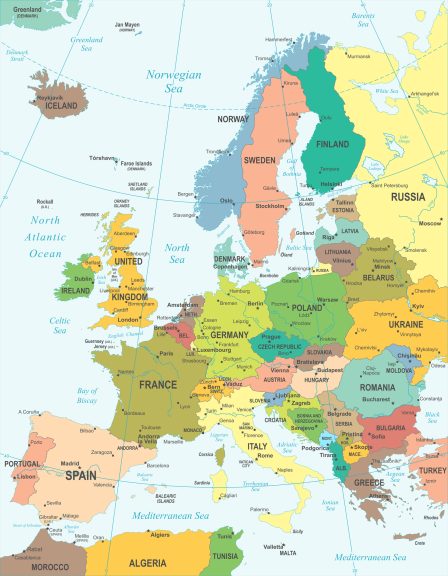News that the French economy has reached a debt-to-GDP ratio of 113% and that this is expected to climb further to 125% by 2030 has alarmed economists, who are stating that these levels are unsustainable and could create serious future damage. GDP/debt ratio figures represent the percentage of debt that a country has as compared to its annual productivity.
Debt levels, however, vary significantly across Europe, depending upon multiple factors, such as good fiscal policies as well as a balanced attitude towards major expense items – such as energy purchases and military expenditure. The economic trick is to match expenses against cash flow. Yet some governments, when in power, spend whatever money is in the national reserves and borrow when that runs out. When borrowings begin to become expensive, cuts to citizens’ social services are usually made to lessen expenses. The recent case of Germany’s chancellor saying the country could no longer afford to meet its old-age pensioners’ requirements – people who have been paying into the state for decades – is an example. Instead of saving their citizens’ own money, the German government spent it. It is significant that Germany also has a relatively low debt to GDP ratio (62.6%), suggesting their previous borrowing rates have been well managed. However, this also indicates that countries with far higher ratios have even more significant problems.

The European Commission does have guidelines in place as concerns member states’ fiscal management, stating that the public debt should not exceed 60% of GDP. However, this is not enforceable.
In this article we examine the top ten worst debt-to-GDP ratios in Europe, with data from Eurostat and the UK government (from CEIC) for Q1 2025.
| Country | Debt/GDP Ratio % | 2025 GDP Growth (f) % YoY |
| Greece | 152.5 | 1.7 |
| Italy | 137.9 | 0.6 |
| France | 114.1 | 0.6 |
| Belgium | 106.8 | 1.0 |
| Spain | 103.5 | 2.5 |
| United Kingdom | 101.1 | 1.2 |
| Portugal | 94.7 | 1.6 |
| Finland | 86.4 | 0.7 |
| Austria | 82.9 | -0.1 |
| Hungary | 73.5 | 0.7 |
| Average Eurozone | 88.1 | 1.6 |
It should be noted that the current forecast for their respective GDP growth rates are insufficient to make any meaningful difference to their national debt. It is also interesting to note that most of these countries are in Western Europe. We can compare with the eastern EU nations bordering either Belarus or Russia as follows:
| Estonia | 18.4 | 0.7 |
| Latvia | 45.2 | 1.0 |
| Lithuania | 40.6 | 2.8 |
| Norway | 55.1 | 1.5 |
| Poland | 55.3 | 0.4 |
| Sweden | 33.5 | 0.9 |
It is unclear why the EU’s eastern borders are performing better and have apparently borrowed less money to finance their economies than their western EU counterparts, possibly a hangover from Soviet-era fiscal prudence? That is something other social economists should look into. These figures are relatively healthy, although it should be noted that the Norwegian and Polish figures are at record highs. In fiscal terms, Eastern Europe would be well advised not to alter their prudent strategies to add debt to the levels of the West.
| Belarus | 42.9 | 4.1 |
| Russia | 19.0 | 1.5 |
In comparison with Belarus and Russia, we can also see healthy debt/GDP ratios. Russia has one of the lowest ratios in the world. Growth rates in Russia, however, are more subdued than they otherwise would have been, mainly because of the sanctions measures imposed upon it by the EU. The main economic difference in these two countries compared with the European nations above is that both Belarus and Russia have access to cheap energy resources, whereas the EU has moved away from this policy and begun to borrow to finance its energy needs.
Summary
The main concern with the European data is that high debt levels such as these begin to eat into public services as governments attempt to reduce this fiscal overload. Naturally, that then creates social unrest leading to political unrest, as we have just seen in the collapse of the French government. In attempting to reduce costs, the government introduced measures to reduce public spending, resulting in social protests and eventually a vote of ‘no confidence’ in the government. France has now just appointed its fifth prime minister since 2024, becoming politically unstable as a result. The main leader of the opposition, pro-Russian Marie Le Pen, has been barred from running for office, while the new Prime Minister, Sébastien Lecornu, appointed on September 9, has already faced public protests. He has stated he intends to suppress these and introduce measures to stop them. He was previously the minister of the French Armed Forces. The potential for increasing French public/government conflict is clear to see.
The concern for Europe is twofold, the immediate concern being that what has occurred in France will spread, especially if social services are curtailed and public costs continue to increase. That has already resulted in the suspension of political candidates that do not fit the establishment’s preferences and the increasing fiscal and police bullying of the general public.
The second concern, which keeps being pushed away, is the high levels of debt. No one seems able or willing to grasp the fiscal situation and to put into place significant economic measures to correct it. The second reality dictates the first, and until someone can appear who is both strong enough and has the political mandate to do so, the short-medium-term economic prognosis for Western Europe is not positive. Eastern Europe would be wise not to follow in its footsteps.
Further Reading
Commonwealth Of Independent States GDP To Equal European Union’s By 2050






